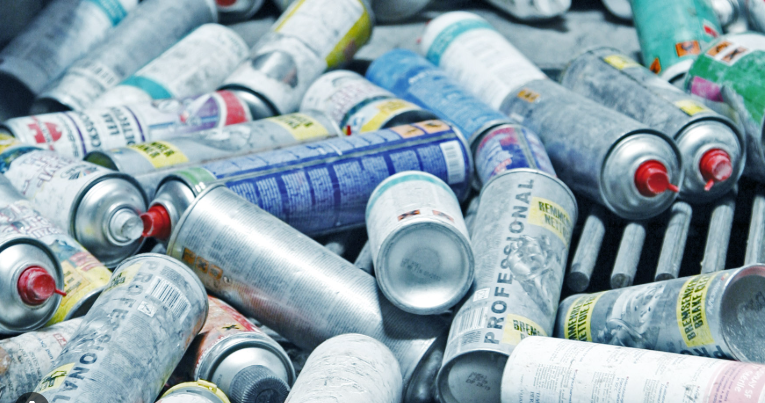Аэрозольные банки везде. От продуктов личной гигиены, таких как дезодоранты, до домашних уборщиков и красок, Эти контейнеры с давлением играют важную роль в нашей повседневной жизни. Пока они предлагают удобство, Они также ставят вызов, когда дело доходит до утилизации. Утилизация аэрозольных банок имеет решающее значение для экологической устойчивости, Помогая уменьшить загрязнение, сохранить ресурсы, и предотвратить вред дикой природе и здоровью человека.

История аэрозольных банок
Аэрозольные банки были изобретены Эрик Ротейм, норвежский инженер, в 1926. Изобретение Ротейма дает новую жизнь упаковке, позволяя распылять жидкости как тонкий туман или пена. Это инновация адаптирована для широкого спектра приложений очень скоро, в том числе домашние чистящие средства, косметика, и даже репелленты насекомых.
Во время Второй мировой войны, США. Военные использовали аэрозольные технологии для распределения инсектицидов для защиты солдат от малярии в Тихом океане. После войны, Аэрозольные банки становятся популярными на потребительском рынке, Особенно для продуктов личной гигиены.
Влияние аэрозольных банок на окружающую среду
Несмотря на их удобство, Аэрозольные банки могут быть вредными для окружающей среды. Если не утилизируется правильно. Многие аэрозольные банки содержат опасные материалы, в том числе легковоспламеняющиеся или токсичные химические вещества. Неправильная утилизация этих банок может привести к вредным выбросам, Загрязнение почвы, и даже опасные взрывы.
Утилизация аэрозольных банок жизненно важна для экологической устойчивости. Это не только уменьшает отходы, которые заканчиваются на свалках. Но это также гарантирует, что ценные металлы, такие как алюминий и сталь, повторно используются. Оба эти металлы можно переработать на неопределенный срок, не теряя их свойства, делая их необходимыми для сохранения природных ресурсов.
Воздействие на окружающую среду не утилизацию аэрозольных банок
Когда аэрозольные банки не переработаны, Они способствуют растущей проблеме твердых отходов на свалках. Хуже, Многие аэрозольные банки содержат химические вещества, которые могут нанести вред атмосфере при выпуске. Например, Аэрозольные банки используют хлорофторублеги (CFCS). Который обнаружил, что истощает озоновый слой. Хотя ХФУ были в значительной степени сняты, Современные аэрозольные банки все еще могут содержать летучие органические соединения (Вокал) которые способствуют загрязнению воздуха и глобальному потеплению.
Если аэрозольные банки прокола или раздавливание на свалках, они взорвутся. Потенциально причинение вреда отходам и вызывает пожары. Вот почему правильная утилизация и утилизация аэрозольных банок имеют решающее значение.
Как правильно утилизировать аэрозольные банки
Безопасно утилизировать аэрозольные банки, Следуйте этим шагам:
- Полностью используйте продукт
Перед удалением аэрозольной банки, Убедитесь, что это пусто. Распыление до тех пор, пока не сможет выпускать продукт, гарантирует, что внутри нет остаточных химических веществ. Который может представлять риск. - Проверьте местные программы утилизации
Различные области имеют разные рекомендации по переработке аэрозольных банок. Некоторые муниципалитеты принимают их. В то время как другие требуют, чтобы вы взяли их в специализированный центр переработки. Проконсультируйтесь с местной службой управления отходами для конкретных инструкций. - Не прокола и не раздавите
Никогда не пытайтесь проколоть или раздавить аэрозоль.. Давление контейнера может привести к взрыву. Приводя к травмам или освобождению вредных химикатов. - Распоряжаться опасными банками в Утилизация Центр
Если аэрозоль может содержать опасные материалы, такие как краски, пестициды, или химикаты, его следует перенести на завод по опасным отходам.
Аэрозоль может переработать: Почему это важно
Утилизация аэрозольных банок - один из наиболее эффективных способов минимизации их воздействия на окружающую среду. Когда эти банки перерабатывают, Материалы могут повторно использовать для создания новых продуктов, Сокращение спроса на сырье. Это сохраняет энергию, уменьшает выбросы парниковых газов, и уменьшает потребность в добыче новых металлов.
Вот некоторые ключевые преимущества аэрозольной банки переработки:
- Сохранение ресурсов
Большинство аэрозольных банок изготовлены из алюминия или стали. Оба из которых можно перерабатывать на неопределенный срок. Утилизация только одного алюминиевого аэрозоля может сэкономить достаточно энергии для питания телевизора в течение трех часов. - Снижение загрязнения
Утилизация аэрозольных банок предотвращает протекание опасных химических веществ в окружающую среду. Это также уменьшает выпуск вредных ЛОС в атмосферу. - Нижние выбросы парниковых газов
Производство новых металлов требует значительного количества энергии. Который часто происходит от сжигания ископаемого топлива. Путем переработки аэрозольных банок, Мы можем сократить потребность в производстве новых металлов и ассоциации выбросов парниковых газов. - Экономия энергии
Утилизация алюминия 95% меньше энергии, чем производить его из сырья. Утилизация стали также экономит энергию, хотя процент немного ниже примерно в 60%.
Будущее аэрозоля может переработать
Утилизация аэрозольные банки значительно прогрессирует в день. Благодаря достижениям в области утилизации технологий и повышения осведомленности. Однако, Есть еще место для улучшения. Более комплексные программы переработки и более строгие правила на опасные материалы могут помочь увеличить скорость переработки аэрозольных банок по всему миру.
Инновации в дизайне аэрозольных банок также на горизонте. Некоторые компании работают над разработкой заполненных аэрозольных контейнеров и изучении альтернативных материалов, которые являются Eco-Friendlier. Эти усилия направлены на то, чтобы еще больше уменьшить воздействие на экологическую площадку аэрозольных банок и сделать утилизацию еще более эффективной.
Часто задаваемые вопросы
- Могут ли переработать все аэрозольные банки?
Большинство аэрозольных банок, изготовлен из стали или алюминия, пригодны для переработки. Однако, Вы должны распоряжаться банками, содержащими опасные материалы на опасных отходах.
2. Что произойдет, если вы бросите аэрозоль в мусорное ведро?
Если не правильно распоряжаться, Аэрозольные банки могут взрываться при раздавении или прокол. Они также могут выпустить вредные химические вещества в окружающую среду.
3. Как мне избавиться от пустой аэрозольной банки?
Как только аэрозольные банки полностью пусты, Поместите в обычную корзину. Обязательно проверяйте в местной программе утилизации конкретных рекомендаций.
4. Почему важно перерабатывать аэрозольные банки?
Переработка аэрозольных банок сохраняет природные ресурсы, уменьшает загрязнение, экономит энергию, и помогает снизить выбросы парниковых газов.
5. Как я могу сказать, может ли аэрозоль пуст?
Вы можете сказать, что аэрозоль может пуста, когда он больше не выпускает ни одного продукта или звука, когда нажимается сопло.
Заключение
Утилизация аэрозольных банок - это простой, но эффективный шаг к экологической устойчивости. Правильно утилизируя и перерабатывая эти общие предметы домашнего обихода. Так, Мы можем уменьшить загрязнение, сохранить ресурсы, и помочь защитить нашу планету для будущих поколений. С продолжающимися инновациями и повышенной осведомленностью, Аэрозоль может быть утилизацией станет еще более эффективной в ближайшие годы.
Потратить время на переработку аэрозольных банок может показаться небольшим. Но это имеет большое значение в долгосрочной перспективе. Давайте внесем свой вклад, чтобы сохранить нашу окружающую среду чистой и устойчивой!






















